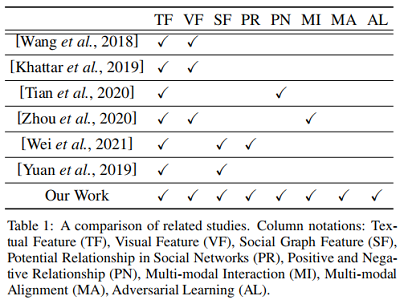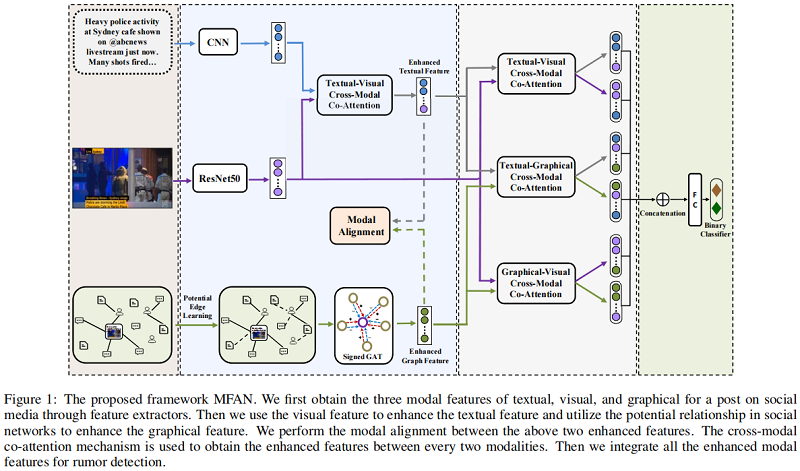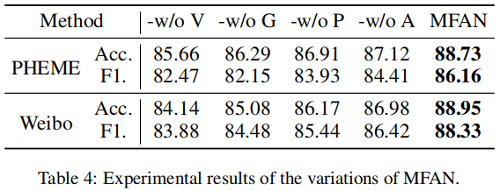謠言檢測——《MFAN: Multi-modal Feature-enhanced Attention Networks for Rumor Detection》
論文資訊
論文標題:MFAN: Multi-modal Feature-enhanced Attention Networks for Rumor Detection
論文作者:Jiaqi Zheng, Xi Zhang, Sanchuan Guo, Quan Wang, Wenyu Zang, Yongdong Zhang
論文來源:2022,IJCAI
論文地址:download
論文程式碼:download
Abstract
本文提出的模型 MFAN 第一次將 文字、視覺和社圖譜特徵 融入同一個框架中。此外,還同時考慮了互補和不同模態之間的對齊關係來達到更好的融合。
1 Introduction
傳統的謠言檢測模型主要依賴與提取文字特徵作為源帖表示,然後做分類。提出融合文字和視覺特徵比單獨使用文字效果更好工作:[Khattar et al., 2019;Wang et al., 2018; Zhou et al., 2020],上述工作的缺點在於沒有考慮 graphical social contexts simultaneously,使用這種東西被證明有益的工作 [Yuan et al., 2019]。
- 節點表示學習的質量高度依賴於實體之間的可靠連結。由於隱私問題或資料爬行約束,可用的社交圖譜資料很可能缺乏實體之間的一些重要的連結。因此,有必要補充社交圖譜上的潛在連結,以實現更準確的檢測;
- 圖上相鄰節點之間可能存在各種潛在關係,而傳統的圖神經網路(GNN)鄰域聚合過程可能無法區分它們對目標節點表示的影響,導致效能較差;
- 如何有效地將學習到的社會圖譜特徵與其他模態特徵(如視覺特徵)整合起來,在現有的研究中探索較少。
具體地說,引入了自我監督損失來對齊從兩種不同的檢視中學習到的源後表示,即文字-視覺檢視和社會圖檢視,旨在提高每個檢視中的表示學習。一方面,我們提出了推斷社交圖中節點之間的潛在連結,以緩解不完全連結問題。另一方面,我們利用有符號注意機制來捕獲正和負鄰域相關性,以實現更好的節點表示。通過上述增強的跨模態融合和社交圖表示學習,我們可以提高多媒體謠言檢測的效能。
貢獻:
- 提出了一種用於多媒體謠言檢測的多模態特徵增強注意網路,它可以有效地將文字、視覺和社會圖的特徵結合在一個單一的框架中。
- 引入了一種自監督損失來在不同的檢視中對齊源後表示,以實現更好的多模態融合。
- 通過增強圖的拓撲結構和鄰域聚合過程來改進社會圖的特徵學習。
- 經驗表明,該模型可以有效地識別謠言,並在兩個大規模的真實資料集上優於最先進的基線。
2 Related Work
相關工作對比:

3 Problem Defnition
Let $P=\left\{p_{1}, p_{2}, \cdots, p_{n}\right\}$ be a set of multimedia posts on social media with both texts and images. For each post $p_{i} \in P$ , $p_{i}=\left\{t_{i}, v_{i}, u_{i}, c_{i}\right\}$ , where $t_{i}$, $v_{i}$ and $u_{i}$ denote the text, image and user who have published the post. $c_{i}=\left\{c_{i}^{1}, c_{i}^{2}, \cdots, c_{i}^{j}\right\}$ represents the set of comments of $p_{i}$ . Moreover, each comment $c_{i}^{j}$ is posted by a corresponding user $u_{i}^{j}$ .
In order to represent user behaviors on social media, we establish a graph $G=\{V, A, E\}$ , where $V$ is a set of nodes, including user nodes, comment nodes, and post nodes. $A \in\{0,1\}^{|V| *|V|}$ is an adjacency matrix between nodes to describe the relationships between nodes, including posting, commenting, and forwarding. $E$ is the set of edges.
We define rumor detection as a binary classification task. $y \in\{0,1\}$ denotes class labels, where $y=1$ indicates rumor, and $y=0$ otherwise. Our goal is to learn the function $F\left(p_{i}\right)=y$ to predict the label of a given post $p_{i}$ .
4 Methodology
我們建議的重點是有效地結合文字、視覺和社交圖特徵,以提高謠言檢測。為此,我們首先提取了這三種型別的特徵。為了產生更好的社會圖特徵,我們提出了基於GAT的圖拓撲和聚合過程。然後,我們捕獲跨模態互動和對齊,以實現更好的多模態融合。最後,我們連線了增強的多模態特徵來進行分類。我們還應用對抗性訓練來提高魯棒性。整個體系結構如 Figure 1 所示。

4.1 Textual and Visual Feature Extractor
Textual Representations
對於每個貼文 $p_{i}$,它的文字內容 $t_{i}$ 被填充或者截斷為相同長度 $L$ 的 Token ,可以表示為:
$\mathcal{O}_{1: L}^{i}=\left\{o_{1}^{i}, o_{2}^{i}, \cdots, o_{L}^{i}\right\} \quad\quad\quad(1)$
其中,$o \in \mathbb{R}^{d}$ 是 $d$ 維的詞嵌入,$o_{j}^{i}$ 表示 $t_{i}$ 的第 $j$ 個詞的嵌入詞。【One-hot】
對上述的 Token 即 詞嵌入矩陣 $\mathcal{O}_{j: j+k-1}^{i}$,使用折積 CNN 獲得特徵對映 $s_{i j}$,其中 $k$ 是感受野的大小,上述特徵對映可以完整表達為:$s^{i}= \left\{s_{i 1}, s_{i 2}, \cdots, s_{i(L-k+1)}\right\}$,然後在完整的特徵對映 $s^{i}$ 上使用最大池化獲得 $\hat{s}^{i}=\max \left(s^{i}\right) $,這裡使用不同的折積核 $k \in\{3,4,5\}$ 來獲得不同粒度的語意特徵。最後,我們 concat 所有 flters 的輸出,形成 $t_i$ 的整體文字特徵向量:
$R_{t}^{i}=\operatorname{concat}\left(s_{k=3}^{i \hat{i}}, s_{k=4}^{\hat{i}}, s_{k=5}^{\hat{i}}\right) \quad\quad\quad(2)$
Visual Representations
使用預訓練框架 $\operatorname{ResNet} 50$ 獲得貼文中影象 $v_i$ 的特徵嵌入 $V_{r}^{i}$,最後將其輸入一個全連線層,即:
$R_{v}^{i}=\sigma\left(W_{v} * V_{r}^{i}\right) \quad\quad\quad(3)$
4.2 Enhanced Social Graph Feature Learning Inferring Hidden Links
為緩解缺失連線的問題,我們建議來推斷社群網路中節點之間的隱藏連結。具體地說,我們將節點嵌入矩陣轉換為 $X \in \mathbb{R}^{|V| \times d}$,其中 $d$ 是維數大小。$X$ 中有三種型別的節點,我們使用句子向量作為貼文和評論節點的初始嵌入,並使用使用者釋出的後節點嵌入的平均值作為初始使用者嵌入。
為緩解缺失連線的問題,我們建議來推斷社群網路中節點之間的隱藏連結。節點嵌入矩陣為 $X \in \mathbb{R}^{|V| \times d}$ ,
一個使用者可以釋出多個貼文
使用句子向量作為貼文和評論的初始嵌入 [ 貼文 包含多個 sentance ]
使用貼文嵌入的平均值作為作為初始的使用者嵌入
貼文 包含文字,使用文字 的嵌入作為貼文的初始嵌入
評論 包含文字,使用文字 的嵌入作為評論的初始嵌入
使用者嵌入通過計算貼文嵌入的平均值獲得
然後根據節點 $n_{i}$ 和 $n_{j}$ 的餘弦相似度計算它們之間的相關性 $\beta_{i j}$
$\beta_{i j}=\frac{x_{i} \cdot x_{j}}{\left\|x_{i}\right\|\left\|x_{j}\right\|} \quad\quad\quad(4)$
其中,$x_{i}$ 和 $x_j$ 是 $n_i$ 和 $n_j$ 的節點嵌入。如果相似度大於 $0.5$,我們推斷它們之間存在一個潛在的邊,即:
$e_{i j}=\left\{\begin{array}{l}0, \text { if } \beta_{i j}<0.5 \\1, \text { otherwise }\end{array}\right. \quad\quad\quad(5)$
然後利用推斷的勢邊增強原始鄰接矩陣 $A \in \mathbb{R}^{|V| \times|V|}$。$a_{i j}$ 表示 $A$ 的元素,其中 $a_{i j}=1$ 表示 $n_{i}$ 和 $n_{j}$ 之間有一條邊,否則則表示 $a_{i j}=0$。然後將增強鄰接矩陣 $A^{\prime}$ 中的元素 $a_{i j}^{\prime}$ 定義為
$a_{i j}^{\prime}=\left\{\begin{array}{l}0, \text { if } e_{i j}=0 \text { and } a_{i j}=0 \\1, \text { otherwise }\end{array}\right. \quad\quad\quad(6)$
Capturing Multi-aspect Neighborhood Relations
通過GAT 計算節點之間的注意力係數:
$\mathcal{E}_{i}=\left\{e_{i 1}^{\prime}, e_{i 2}^{\prime}, \cdots, e_{i\left|\mathcal{N}_{i}\right|}^{\prime}\right\}$
其中節點$n_i$ 和 $n_j$ 之間的注意力:
$e_{i j}^{\prime}=\operatorname{LeakyRe} L U\left(\hat{a}\left[W x_{i} \| W x_{j}^{\prime}\right]\right)\quad\quad\quad(7)$
注意力機制存在的問題:未經過 softmax 的注意力係數可能出現很大的負權:
$\mathcal{E}_{t}=\{0.7,0.3,-0.1,-0.9\}$
注意力權重經過 softmax 的結果為:
$\mathcal{E}_{t}^{\prime}=\{0.43,0.29,0.20,0.09\}$
然而,「-0.9」可能表示這兩個節點向量的處於相反位置。顯然這種負相關的關係對於謠言檢測很有幫助,如一個人說了與其行為不相關的評論。
受到 QSAN 的啟發,本文使用了一種符號注意力機制 Signed GAT,具體地說,對於節點 $n_{i}$,我們將其相鄰節點的注意權值 $\mathcal{E}_{i}$ 的反演表示為 $\tilde{\mathcal{E}}_{i}=-\mathcal{E}_{i}$。然後,我們用 softmax 函數計算 $\mathcal{E}_{i}$ 和 $\tilde{\mathcal{E}}_{i}$ 的歸一化權值,
為了捕獲節點之間的正關係和負關係,我們分別利用 $\mathcal{E}_{i}^{\prime}$ 和 $-\tilde{\mathcal{E}}_{i}^{\prime}$ 得到鄰居節點特徵的加權和。然後我們將這兩個向量連線在一起,通過一個全連線層,得到最終的節點特徵。例如,$n_{i}$ 的節點特徵可以通過
$\hat{x}_{i}=\sigma\left(W_{n} *\left(\mathcal{E}_{i}^{\prime} * X_{j} \|-\tilde{\mathcal{E}}_{i}^{\prime} * X_{j}\right)\right)\quad\quad\quad(9)$
例子:
import numpy as np
import torch.nn.functional as F
import torch
if __name__ =="__main__":
data = torch.tensor([ 0.2 ,-1 , 1 ,-0.1 ])
out = F.softmax(data,dim=-1)
print("data = ",data.numpy())
print("softmax data = ",out.numpy())
data = torch.tensor([ 0.2 ,-1 , 1 ,-0.1 ])*-1
out = F.softmax(data,dim=-1)
print("-data = ", data.numpy())
print("softmax data = ",out.numpy())
輸出:
data = [ 0.2 -1. 1. -0.1]
softmax data = [0.2343263 0.07057773 0.5215028 0.1735932 ]
-data = [-0.2 1. -1. 0.1]
softmax data = [0.16341725 0.5425644 0.0734281 0.22059022]
然後利用 Signed GAT 從增強的圖中提取圖的結構特徵。對於每個節點,我們根據 $\text{Eq.9}$ 更新其嵌入,得到更新後的節點嵌入矩陣 $\hat{X} \in \mathbb{R}^{|V| \times d}$,其中 $|V |$ 為節點數,$d$ 為維數大小。然後採用多頭注意機制,從不同的角度捕捉特徵。我們將每個頭部的更新後的節點嵌入連線在一起,作為整體的圖特徵:
$\hat{G}=\|_{h=1}^{H} \sigma\left(\hat{X}_{h}\right)\quad\quad\quad(10)$
其中,$H$ 為頭的數量。然後,第 $i$ 個貼文的圖特徵 $R_{g}^{i}$ 對應於 $\hat{G}$ 的第 $i$ 個列。
4.3 Multi-modal Feature Fusing
在本工作中,由於有三種型別的資料,我們採用了具有共同注意方法的層次融合模式[Lu et al.,2019]。為了捕獲跨模態關係的不同方面並增強多模態特徵,我們提出在自監督損失下強制執行跨模態對齊。
Cross-modal Co-attention Mechanism
${\large Z_{t}^{i}=\left(\|_{h=1}^{H} \operatorname{softmax}\left(\frac{Q_{t}^{i} K_{t}^{i^{T}}}{\sqrt{d}}\right) V_{t}^{i}\right) W_{t}^{O}} \quad\quad\quad(11)$
按照上述多頭注意力的方法分別用與圖片特徵 $R_{v}^{i}$ 和圖特徵 $R_{g}^{i} $ 得到兩者的最終表示 $Z_{v}^{i} $ 和 $Z_{g}^{i}$。
接著使用交叉注意力機制,對於文字和視覺特徵,進行如下交叉注意力機制,獲得視覺和文字的特徵:
$Z_{v t}^{i}=\left(\|_{h=1}^{H} \operatorname{softmax}\left(\frac{Q_{v}^{i} K_{t}^{i}}{\sqrt{d}}\right) V_{t}^{i}\right) W_{v t}^{O}\quad\quad\quad(12)$
Note:$Z_{v t}^{i}$ 代表著 text-visual feature 的融合,同理可以得到 visual-text feature 的融合 $Z_{t v}^{i}$。
Multi-modal Alignment
模型對齊:指增強的源帖圖特徵和文字特徵被轉換到相同的特徵空間:
$\begin{array}{l}Z_{g}^{i^{\prime}}=W_{g}{ }^{\prime} Z_{g}^{i} \\Z_{t}^{i^{\prime}}=W_{t}^{\prime} Z_{v t}^{i}\end{array}\quad\quad\quad(13)$
然年通過 MSE 計算文字和視覺特徵的特徵對齊損失:
$\mathcal{L}_{\text {align }}=\frac{1}{n} \sum\limits_{i=1}^{n}\left(Z_{g}^{i^{\prime}}-Z_{t}^{i^{\prime}}\right)^{2}\quad\quad\quad(14)$
然後,我們得到了對齊參考的文字特徵 $\tilde{Z}_{t}^{i}$ 和圖特徵 $\tilde{Z}_{g}^{i}$,它們用於下面的多模態融合。
Fusing the Above Multi-modal Features
再次使用上述的 cross-modal co-attention mechanism 獲得三種模態特徵 $\tilde{Z}_{t}^{i}$、$\tilde{Z}_{g}^{i}$、$Z_{v}^{i}$ 之間的多模態特徵 $\tilde{Z_{t v}^{i}}$、$\tilde{Z_{v t}^{i}}$、$\tilde{Z_{g t}^{i}}$、$\tilde{Z_{t g}^{i}}$、$\tilde{Z_{g v}^{i}}$、$\tilde{Z_{v g}^{i}}$,最後將上述交叉模態特徵拼接得到最終的多模態特徵:
$Z^{i}=\operatorname{concat}\left(\tilde{Z_{t v}^{i}}, \tilde{Z_{v t}^{i}}, \tilde{Z_{g t}^{i}}, \tilde{Z_{t g}^{i}}, \tilde{Z_{g v}^{i}}, \tilde{Z_{v g}^{i}}\right)\quad\quad\quad(15)$
4.4 Classifcation with Adversarial Training
將貼文 $p_{i}$ 的多模態特徵 $Z^{i}$ 輸入全連線層,以預測 $p_{i}$ 是否是謠言:
$\hat{y}_{i}=\operatorname{softmax}\left(W_{c} Z^{i}+b\right)$
其中,$\hat{y}_{i}$ 表示 $p_{i}$ 成為謠言的預測概率。然後我們用交叉熵損失函數作為
$\mathcal{L}_{\text {classify }}=-y \log \left(\hat{y}_{i}\right)-(1-y) \log \left(1-\hat{y}_{i}\right)$
總體損失可寫如下:
$\mathcal{L}=\lambda_{c} \mathcal{L}_{\text {classify }}+\lambda_{a} \mathcal{L}_{\text {align }}$
其中,$\lambda_{c}$ 和 $\lambda_{a}$ 被用來平衡這兩個損失。
5 Experiments
Datasets
- Weibo:微博資料集 ;
- PHEME:Twitter 平臺上的資料,包括5 個 breaking news ;

Baselines
- EANN [Wang et al., 2018] is a GAN-based model exploiting both text and image data. It derives eventinvariant features and benefits newly arrived events.
- MVAE [Khattar et al., 2019] uses a bimodal variational autoencoder coupled with a binary classifier for multimodal fake news detection.
- QSAN [Tian et al., 2020] integrates the quantum-driven text encoding and a novel signed attention mechanism for false information detection.
- SAFE [Zhou et al., 2020] jointly exploits multi-modal features and cross-modal similarity to learn the representation of news articles.
- EBGCN [Wei et al., 2021] rethinks the reliability of latent relations in the propagation structure by adopting a Bayesian approach.
- GLAN [Yuan et al., 2019] jointly encodes the local semantic and global structural information and applies a global-local attention network for rumor detection.
Implementation Details
- training:validation:testing = 7:1:2
- 使用 [Yuan et al., 2019] 的 word vectors 初始化 word embedding。
- $H=8$ 代表著 $8$ 頭注意力
- 並設定 $\lambda_{c} = 2.15$ 和 $\lambda_{a} = 1.55$
Results

Performance of the Variations
「-w/o V」, 「-w/o G」, 「-w/o P」, and 「-w/o A」 分別代表著不使用 visual information, social graph information,potential links, and modal alignment

結果顯示:
(i) visual modal and graph features are both important for rumor detection;
(ii) the modal alignment can facilitate the multi-modal fusion;
(iii) considering latent links can signifcantly improve;
6 Conclusions
在本文中,我們提出了一個多模態謠言檢測框架,它通常包含了三種模態,即文字、影象和社交圖。為了改進社會圖特徵學習,基於GAT增強了圖拓撲和鄰域聚合過程。我們的框架通過引入跨模態對齊來實現更有效的多模態融合。對中文和英語資料集的評估和比較表明,我們的模型可以優於最先進的多媒體謠言檢測基線。
因上求緣,果上努力~~~~ 作者:關注我更新論文解讀,轉載請註明原文連結:https://www.cnblogs.com/BlairGrowing/p/16670861.html